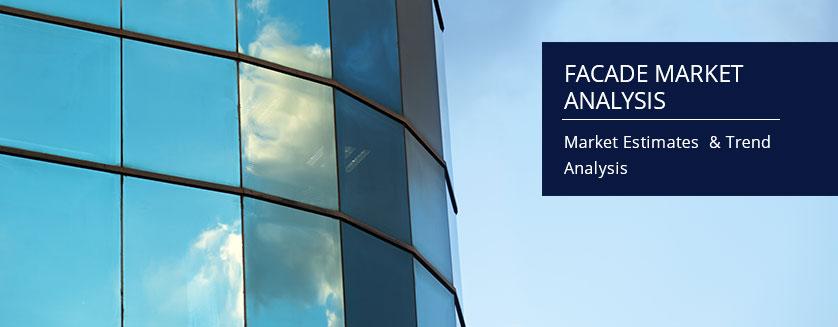
Façade Market Analysis & Forecasts, 2013-202
The global facades market size is expected to reach USD 339.46 billion by 2024, according to a new study by Grand View Research, Inc. The surge in the adoption of advanced eco-friendly facades across North America and Europe is anticipated to fuel the market growth in the coming years. Furthermore, technological innovations have led to the development of energy saving facade materials. These advanced products absorb solar energy and find a widespread adoption in many commercial and residential buildings as a secondary source of electricity generation.
This growth is ascribed to the rising customer spending power, primarily in China, Japan, India, Brazil, and GCC countries, along with the need to provide a secure work environment to employees. Furthermore, the increasing use of metal composite materials offers a durable, harmonious, and modern appearance to the building. The usage of such composite materials to build facades is expected to be the key trend affecting the market growth positively over the next eight years.
Further key findings from the study suggest:
Product Insights
Curtain walls are expected to emerge as the fastest growing product segment in the market, owing to the increasing penetration in commercial buildings. They mainly comprise glass materials that can transmit heat to provide a warm atmosphere in regions with a low temperature. As a result, they are also likely to gain a high demand in residential applications in the near future, primarily in the U.S., the UK, and other colder parts of Europe.
The industry, at present, is dominated by classic designs, which are anticipated to be replaced by a modern, eco-friendly designs over the next eight years. The ease of raw material availability and rapid demand in the end-use sector, including the commercial and industrial sectors, owing to the recovery of the global economy, is anticipated to generate opportunities for industry players over the forecast period.
The ventilated type dominated the market in 2015 and is expected to witness a modest growth as this type of wall coverings shield buildings against the combined action of wind and rain. These facades counter balance the result of water beating on walls and, thus, keep the building dry. This product also provides heat insulation and sound proofing to the building interior and is expected to further catapult demand over the next few years.
Material Insights
The major innovations in the composite materials development have led to overcome several limitations of excess heat and soundproofing. Several basic materials used in the development of the product include aluminum, plastic & fiber, glass, ceramic, and steel. Aluminum and glass-based composite materials are significantly used to build facades, owing to their low weight and high transparency respectively.
Aluminum and glass are highly preferred due to their durable and elastic properties. This allows designers to provide a proper shape and size to the facades. Investments in R&D have also led to the development of eco-friendly or sustainable bio-climatic “Second-Skin facades”to make use of the environment for building lighting, heating, and cooling.
End-Use Insights
Facades are extensively used in commercial and residential buildings to protect the interior and provide a visually appealing outer architecture. The product is significantly used in commercial buildings due to the availability of high construction budget among corporates. The rise in the number of commercial buildings, such as retail stores, hotels, medical centers, warehouses, and garages, in India, China, Brazil and the Middle Eastern countries is anticipated to catapult the product demand over the forecast period.
The product penetration in residential buildings is also anticipated to increase over the next few years owing to the rising customer awareness pertaining to energy saving, primarily in the U.S., the UK, Germany, and Japan.
Regional Insights
Asia Pacific dominated the market with more than 30% revenue share in 2015. This is attributed to the increasing construction of new commercial and industrial buildings in countries including China, India, and Southeast Asia over the next eight years. Furthermore, the development of innovative eco-friendly materials is also anticipated to instigate customers, particularly in the U.S. and the UK, to redevelop buildings.
North America and Europe collectively accounted for over 40% of the total share in 2015 owing to the growing affinity toward the adoption of advanced facade materials. These regions are highly adaptive to new technologies. As a result, the penetration of the product in commercial and residential sectors is expected to be high, favorably impacting the industry growth.
Download the full report: Grand View Research








